- Clone
- BVD2-21C11 (See other available formats)
- Regulatory Status
- RUO
- Other Names
- Granulocyte/macrophage colony-stimulating factor, CSF-α, Pluripoietin-α, Eosinophil colony stimulating factor (Eo-CSF), Burst promoting activity (BPA)
- Isotype
- Rat IgG2a, κ
- Ave. Rating
- Submit a Review
- Product Citations
- publications
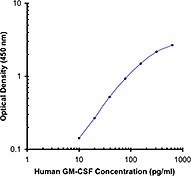
| Cat # | Size | Price | Quantity Check Availability | Save | ||
|---|---|---|---|---|---|---|
| 502304 | 500 µg | 263€ | ||||
Granulocyte/macrophage - colony stimulating factor (GM-CSF) is a hematopoietic factor that is produced by activated T cells, B cells, mast cells, macrophages, fibroblasts, and endothelial cells. In addition to supporting colony formation of granulocyte/macrophage progenitors, GM-CSF is a growth factor for erythroid, megakaryocyte, and eosinophil progenitors.
Product DetailsProduct Details
- Reactivity
- Human
- Antibody Type
- Monoclonal
- Host Species
- Rat
- Immunogen
- E. coli-expressed, recombinant human GM-CSF.
- Formulation
- Phosphate-buffered solution, pH 7.2, containing 0.09% sodium azide.
- Preparation
- The antibody was purified by affinity chromatography, and conjugated with biotin under optimal conditions.
- Concentration
- 0.5 mg/ml
- Storage & Handling
- The antibody solution should be stored undiluted between 2°C and 8°C. Do not freeze.
- Application
-
ELISA Detection, ELISPOT Detection, ICFC
- Recommended Usage
-
Each lot of this antibody is quality control tested by ELISA assay. For use as an ELISA detection antibody, a concentration range of 0.25-1.0 µg/ml is recommended. To obtain a linear standard curve, serial dilutions of human GM-CSF protein ranging from 500 to 4 pg/ml are recommended for each ELISA plate. It is recommended that the reagent be titrated for optimal performance for each application.
- Application Notes
-
Additional reported applications (for the relevant formats) include: ELISA1-4 or ELISPOT3,4 Detection, Neutralization1, immunohistochemical staining of paraformaldehyde-fixed, saponin-treated5,6 and acetone-fixed7 frozen tissue sections, and immunocytochemistry.
Note: For testing human GM-CSF in serum or plasma, BioLegend's ELISA Max™ Sets (Cat. No. 432001 to 432006) are specially developed and recommended.
- Application References
-
- Abrams J, et al. 1992. Immunol. Rev. 127:5. (ELISA, Neut, IP)
- Abrams J, et al. 1994. Eosinophils in Allergy and Inflammation. Marcel Dekker New York. p.133. (ELISA)
- Bacchetta R, et al. 1990. J. Immunol. 144:902. (ELISA)
- Kita H, et al. 1991. J. Exp. Med. 174:745. (ELISA)
- Andersson U, et al. 1999. Detection and quantification of gene expression. New York:Springer-Verlag. (IHC)
- Andersson J, et al. 1994. Immunology 83:16. (IHC)
- Rasouli J, et al. 2015. J. Immunol. 11:5085-93. (IHC)
- Product Citations
- RRID
-
AB_315218 (BioLegend Cat. No. 502304)
Antigen Details
- Structure
- Cytokine; 22 kD (Mammalian)
- Bioactivity
- Growth/development factor for granulocyte/macrophage progenitors; differentiates myeloblasts/monoblasts; synergizes with Epo proliferation of erythroid/megakaryocytic progenitors
- Cell Sources
- T cells, macrophages, fibroblasts, endothelial cells, mast cells
- Cell Targets
- Granulocyte/macrophage/erythroid/megakaryocytic progenitors, myeloblasts, monoblasts
- Receptors
- Heterodimer GM-CSFR α subunit (CDw116); β-subunit (CDw131), which is also shared with the IL-3 and IL-5 receptor α chains
- Biology Area
- Cell Biology, Stem Cells
- Molecular Family
- Cytokines/Chemokines, Growth Factors
- Antigen References
-
1. Fitzgerald K, et al. Eds. 2001. The Cytokine FactsBook. Academic Press San Diego.
2. Demetri G, et al. 1991. Blood 78:2791.
3. Fan D, et al. 1991. In vivo 5:571.
4. Negrin R, et al. 1992. Adv. Pharmacol. 23:263. - Regulation
- Synergistic with IL-1, IL-3, G-CSF; E21R competitive antagonist for receptor binding; stored in ECM with heparan sulfate proteoglycans
- Gene ID
- 1437 View all products for this Gene ID
- UniProt
- View information about GM-CSF on UniProt.org
Related FAQs
- How many biotin molecules are per antibody structure?
- We don't routinely measure the number of biotins with our antibody products but the number of biotin molecules range from 3-6 molecules per antibody.
Customers Also Purchased
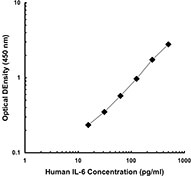
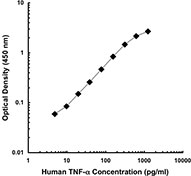
Compare Data Across All Formats
This data display is provided for general comparisons between formats.
Your actual data may vary due to variations in samples, target cells, instruments and their settings, staining conditions, and other factors.
If you need assistance with selecting the best format contact our expert technical support team.
 Login / Register
Login / Register 









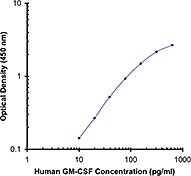
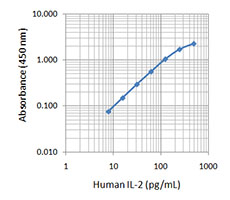



Follow Us